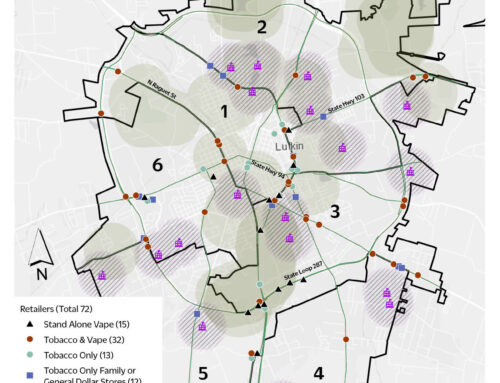Colleges and universities across the country have had success in using policy to protect students from exposure to secondhand smoke on campus. However, these policies do not address the tobacco retail environment immediately off-campus. Considering the off-campus retail environment in tobacco control efforts can be the perfect next step to further protecting the health of college students and their communities.
Colleges and universities across the country have had significant success in using policy to protect their students and employees from exposure to secondhand smoke on campus. In fact, as of February 2022, there are close to 2,600 100% smokefree campuses, with a large majority of these sites being 100% tobacco-free. However, these policies do not address the tobacco retail environment immediately off-campus. Research shows that tobacco availability and marketing can have a significant impact on smoking behavior. This is an especially important consideration in areas full of young adults. Young adults are one of Big Tobacco’s favorite target audiences since 9 out of 10 daily smokers start before age 18.
The tobacco industry channels billions of dollars into the retail environment, which is the primary place where college students are exposed to tobacco marketing. In the United States, close to 40% of colleges are located within 3 miles of a hookah lounge and almost 70% are located within 3 miles of a vape shop. In a study of California colleges and universities, analysis showed that retailers cluster near campuses, even when accounting for population size, and nearly all community colleges and 4-year colleges in the state are located within 3 miles of at least one licensed tobacco retailer. This data points to convenient access to tobacco products for college students.
We know the retail availability of tobacco is important for a number of reasons, including:
- Perpetuation of social norms about tobacco use. The ubiquitous presence of tobacco retailers gives the impression that tobacco is available and socially acceptable.
- Contributions to higher smoking rates. Tobacco retail outlet density is associated with higher rates of tobacco use, as well as higher rates of tobacco use initiation among youth and young adults.
- Increased exposure to industry point-of-sale advertising, marketing and promotions. The tobacco industry channels most of its marketing dollars into the retail environment because they are well aware of how successful this marketing can be. In addition, this exposure leads to increased brand recognition, which increases odds of smoking.
- Reduced search costs for tobacco products. By requiring less effort to attain tobacco products, it is easier for young adults to start or continue smoking. Proximity to tobacco retailers can also encourage impulse purchases and reduce the success of quit attempts for people looking to curb their tobacco use.
- Contribution to social and environmental inequities. Tobacco retail outlet density is higher in low income and minority neighborhoods, fueling disparities in tobacco use and its associated health effects.
There are several different strategies for reducing retailer density, including using strong licensing or zoning policies to cap the number of retailers or limiting their proximity to locations such as schools. Mapping the point locations of tobacco retailers in the vicinity of college campuses offers powerful insight into the potential of these policies to reduce access to tobacco products.
Because most local and state smokefree laws do not cover college or university campuses, colleges and universities have had to work hard to create smokefree environments on campus for their students and staff. The hard work doesn’t have to end there. Considering the off-campus retail environment in tobacco control efforts can be the perfect next step to further protecting the health of college students and their communities.
Additional Resources
- Licensing, Zoning, and Retailer Density, Counter Tools
- Tobacco Retailer Density- Place Based Strategies to Advance Health and Equity, ChangeLab Solutions
- Using Licensing and Zoning to Regulate Tobacco Retailers, the Public Health Law Center
This post was originally published as a feature article for The Geographic Health Equity Alliance (GHEA), a CADCA initiative. GHEA is a CDC funded National Network dedicated to reducing geographic health disparities related to tobacco and cancer.
Photo by Cole Parsons on Unsplash.





